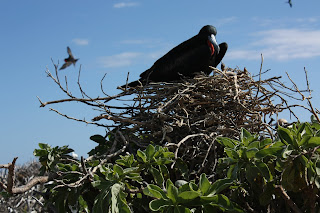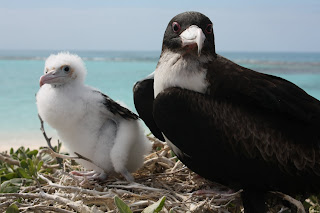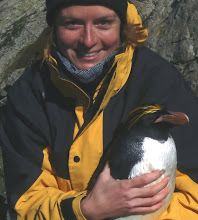
Frigatebirds circling overhead.

Too cool for school- a male frigatebird.

Armed and dangerous.
Come breeding season, however, male frigatebirds turn from supercool, sexy attack machines into a bunch of simpering dolts. The transformation begins around mid-January, when male frigatebirds gather on top of bushes where they can display to passing females. They start by developing long, irridescent blue-green feathers on the back of their necks. Once these feathers are nice and shimmery they inflate a large pouch of bright red skin under their chin. Some males keep the pouch inflated at all times, even though it must be an enormous hinderance to other activities like preening, eating and being able to see where they are going. The males then hang around in the bushes, fully inflated, until a female flies overhead at which point they raise the irridescent neck feathers, spread their wings and do a 'jazz-hands' motion with the wing tips, make a shrill warbling noise and vigorously waggle the red pouch from side to side. One assumes that female frigatebirds find this kind of behaviour tremendously alluring. Female biologists find it hilarious. The female frigates cruise around over the bushes checking out what is on offer, and their presence elicits a kind of Mexican wave of pouch waggling from the males below. The biggest pouch and the most enthusiastic waggling wins the fair lady.

Does my chin look big in this?

Taking a closer look.

Seriously, does my chin look big in this?

Success! A female shows some mild interest.
The female frigatebird eventually chooses a mate by landing next to him and looking slightly bored. At this point the male starts gathering twigs and bringing them back to the female, and together they fashion a ramshackle nest. Here again the frigates' aerial combat skills come to the fore, and they will steal twigs from other birds in daring mid-air battles, or smash-and-grab raids on unguarded nests. The most frequent victims of this behaviour are red-footed boobies, which nest in the same bushes as the frigates but are smaller and less aggressive. Although the frigates relentlessly persecute the boobies in the air, a kind of armistice seems to exist within each individual bush. Frigates and boobies build their nests only inches apart, but they rarely steal twigs from their immediate neighbours. That, it appears, would be bad form.

This frigatebird was very enthusiastic about his nest building.

Already belligerent, a frigate chick.

Mum and baby.

Exhausted after a hard reproductive season.
Don't worry, the bird in the above photo is not dead. Frigates go all out when they relax and can often be seem draped over a bush, wings and head completely limp, as though they can no longer be bothered to resist gravity. Another position they like to sit in is the meditative pose in the picture below. Don't ask me why.

Frigate yoga.

Preparing to roost after a hard days thievin'.


No comments:
Post a Comment